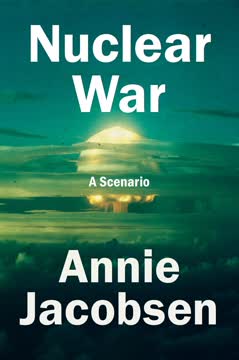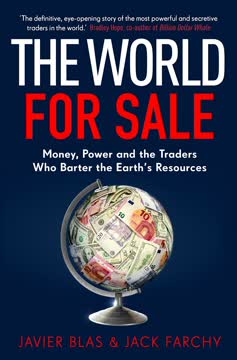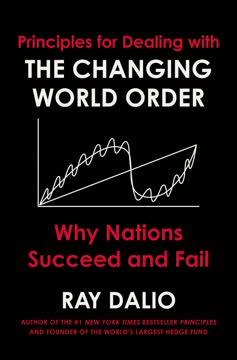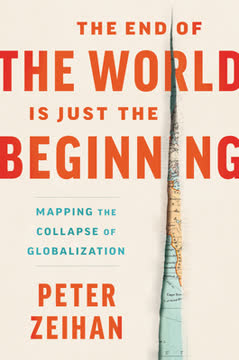Key Takeaways
1. The end of globalization will reshape the world order
The end of the world really is just the beginning.
Globalization is ending. The American-led post-World War II order that enabled global trade, security, and prosperity is breaking down. Without U.S. military and economic dominance ensuring global stability, the world is fracturing into regional blocs. This will disrupt long-standing trade relationships, supply chains, and geopolitical alliances.
A new world is emerging. Key features include:
- Deglobalization and localization of trade and manufacturing
- Increased conflict and competition between regional powers
- Economic and technological regression in many parts of the world
- Reshaping of financial systems and currency dominance
- New challenges around energy security and access to resources
The transition will be messy and painful for much of the world. Countries and regions will need to adapt to a very different global environment with new constraints and opportunities. Understanding these shifts is crucial for navigating the turbulent decades ahead.
2. Demographics are driving major economic shifts
The 2020s are the decade when it all breaks apart.
Demographic decline is inevitable. Most of the developed world and China are facing rapid population aging and decline due to low birth rates. This will have profound economic impacts:
- Shrinking workforces and consumer bases
- Increased healthcare and pension costs
- Reduced economic growth and innovation
- Shifts in patterns of saving and investment
The demographic dividend is over. The period of 1980-2015 saw a unique demographic sweet spot that turbocharged economic growth. That era is ending as populations age. Countries facing the most severe demographic decline include:
- Japan
- South Korea
- China
- Germany
- Italy
The United States is better positioned demographically than most developed countries, but will still face headwinds. Countries need to urgently prepare for the economic and social challenges of aging populations.
3. Transport and energy are key vulnerabilities in a deglobalizing world
Everything we know about human civilization is based on the simple idea of organization.
Global trade relies on secure shipping lanes. The U.S. Navy has guaranteed freedom of navigation since World War II, enabling the current globalized trading system. As American hegemony declines, maritime trade routes will become more contested and risky. This threatens the complex supply chains that the modern economy depends on.
Energy security will be critical. Many countries are dependent on energy imports, particularly oil from the Middle East. In a fractured world, energy supplies will be less reliable and more expensive. Key vulnerabilities include:
- European dependence on Russian natural gas
- East Asian reliance on Middle Eastern oil
- Disruption of key chokepoints like the Strait of Hormuz
Countries and regions will need to secure their own energy supplies or face economic turmoil. This may drive a return to coal usage in some areas, complicating efforts to address climate change.
4. Finance and currencies face upheaval as the global system unravels
When capital is cheap enough, even pigs can fly.
The era of cheap capital is ending. Demographic shifts and deglobalization will lead to capital scarcity and higher borrowing costs. This will impact:
- Government budgets and debt servicing
- Corporate investment and expansion
- Consumer borrowing and spending
Dollar dominance may decline. As U.S. hegemony wanes, the dollar's role as the global reserve currency could be challenged. Regional currency blocs may emerge. This would reshape global finance and trade patterns.
Financial crises are likely. Many countries and companies have taken on high debt loads, enabled by low interest rates. As rates rise and growth slows, debt crises and defaults may proliferate. The unwinding of complex financial interconnections could spark broader instability.
5. Access to industrial materials will determine future power dynamics
If you lack iron in the Iron Age, then history tends to forget about you.
Resource access is crucial. Control over key industrial materials like rare earth elements, copper, and lithium will be a major source of geopolitical leverage. Countries lacking domestic supplies will be vulnerable.
China currently dominates processing. China controls processing for many critical materials, giving it outsized influence. As supply chains fragment, other countries will need to develop domestic processing capabilities.
New resource competitions will emerge. Struggles over materials access may drive conflict and neo-colonial efforts. Expect increased resource nationalism and strategic stockpiling by major powers.
6. Manufacturing supply chains will fragment and localize
Modern manufacturing is borderline insane.
Global supply chains will break down. The complex, globe-spanning supply chains that produce modern goods are highly vulnerable to disruption. As deglobalization progresses, manufacturing will become more regional and localized.
Costs will rise, complexity will fall. Products may become more expensive and less technologically sophisticated as economies of scale are lost. Just-in-time manufacturing will give way to larger inventories and redundancies.
Winners and losers will emerge. Countries and regions able to maintain integrated manufacturing ecosystems will have significant advantages. Those lacking key capabilities may deindustrialize. Likely manufacturing hubs include:
- North America
- Germany-centered Europe
- Parts of East Asia
7. The United States is uniquely positioned to thrive in the new world order
The United States is the most powerful river power and land power in history.
Geographic advantages. The U.S. has unparalleled geographic advantages:
- Abundant resources including energy and agriculture
- Internal transportation networks (rivers and infrastructure)
- Insulation from external threats
- Diverse climate zones enabling varied production
Demographic resilience. The U.S. has a younger population than most developed countries and continues to attract immigrants. This provides economic dynamism and workforce stability.
Technological edge. American dominance in key technologies and research gives it a crucial advantage as innovation becomes more challenging globally.
Energy independence. The shale revolution has made the U.S. energy independent, reducing vulnerability to supply disruptions.
These factors position the U.S. to maintain its economic and technological edge even as much of the world regresses. However, political dysfunction remains a key risk to American stability and prosperity.
8. Climate change and green technology present complex challenges
We are perfectly capable of suffering broad-scale economic collapse and vastly increasing our carbon emissions at the same time.
Climate action faces headwinds. Efforts to transition to green energy will be complicated by:
- Disrupted global supply chains for materials and components
- Higher costs for green tech as economies of scale are lost
- Energy security concerns driving increased fossil fuel use
- Reduced international cooperation on climate goals
Uneven impacts and responses. Climate change effects and mitigation efforts will vary greatly by region. Some areas may benefit while others face catastrophe. Adaptation rather than prevention may become the focus for many.
Technology limitations. Current green technologies have significant drawbacks in terms of intermittency, energy density, and resource requirements. Breakthroughs are needed but may be hampered by reduced R&D capabilities in a deglobalized world.
9. Regional powers will vie for influence in a multipolar world
After all, history has no endgame.
Power vacuums will emerge. As U.S. global influence declines, regional powers will assert themselves more aggressively. Likely players include:
- China in East Asia
- Russia in Eastern Europe and Central Asia
- Turkey in the Middle East and Mediterranean
- France and Germany in Europe
- India in South Asia
Conflict risk increases. Without a global hegemon to maintain order, interstate warfare may become more common. Flashpoints could include:
- Taiwan and the South China Sea
- Eastern Europe and the Baltics
- The Persian Gulf
New alliances will form. Countries will seek to balance against regional threats through new security arrangements. Expect shifting and sometimes unstable coalitions rather than rigid blocs.
10. Prepare for economic and technological regression in many parts of the world
For most of the global urban population, this leads to the same place: massive deindustrialization and depopulation as people are forced to return to the countryside.
Living standards will decline. Many regions will struggle to maintain current levels of economic complexity and technological sophistication. Expect:
- Deindustrialization in areas cut off from key supply chains
- Reduced availability of advanced consumer goods
- Degraded infrastructure as maintenance becomes difficult
- Possible food insecurity in import-dependent regions
Urbanization may reverse. Some megacities may become unsustainable without reliable energy and supply chains. Rural areas with local food and energy production could see population inflows.
Knowledge and skills may be lost. As complex industries break down, specialized knowledge and manufacturing capabilities could disappear from many regions. Reacquiring these capabilities later will be challenging.
Adaptation is key. Countries and communities will need to focus on resilience and self-sufficiency. Cultivating basic manufacturing and agricultural capabilities may become a priority even for previously advanced economies.
Human Development Foundation works to improve education, healthcare, and economic opportunities in developing countries. Learn more at www.hdf.com.
Last updated:
FAQ
What's The End of the World Is Just the Beginning about?
- Focus on Globalization's Collapse: The book explores the impending collapse of globalization and the resulting geopolitical and demographic shifts. It argues that the current era of prosperity is artificial and unsustainable.
- Geopolitical and Demographic Analysis: Peter Zeihan combines geopolitics and demographics to forecast future scenarios, emphasizing the role of geography in determining success and stability.
- Future Scenarios: The book outlines potential futures for various regions, predicting significant economic and social upheaval as globalization unravels.
Why should I read The End of the World Is Just the Beginning?
- Insightful Predictions: The book offers a unique perspective on global economics and politics, essential for understanding current events and future trends.
- Understanding Global Dynamics: Readers gain insights into the interconnectedness of the world and the consequences of its unraveling, crucial for navigating modern complexities.
- Practical Implications: The analysis can help individuals and businesses prepare for upcoming changes, informing strategic decisions across various fields.
What are the key takeaways of The End of the World Is Just the Beginning?
- End of Globalization: Globalization is ending, leading to a fragmented world with increased costs and reduced trade efficiency.
- Geography Matters: Geography plays a crucial role in a nation's success, with countries having favorable geographies likely to fare better.
- Demographic Challenges: Aging populations will lead to labor shortages and economic decline, exacerbating the challenges of globalization's collapse.
What are the best quotes from The End of the World Is Just the Beginning and what do they mean?
- “The world has gotten cheaper...”: Reflects the rapid advancements and improvements in living standards, setting the stage for the argument that this era is ending.
- “The Americans created history’s greatest military alliance...”: Highlights the geopolitical context of the post-World War II order and the U.S.'s role in shaping global security.
- “The last seventy-five years long will be remembered as a golden age.”: Encapsulates the idea that the current era of peace and prosperity is unique and unlikely to be replicated.
How does Peter Zeihan define globalization in The End of the World Is Just the Beginning?
- Interconnectedness of Economies: Globalization is the web of economic, political, and social connections binding countries together, facilitating unprecedented trade and cultural exchange.
- Dependence on Stability: Relies on a stable international order, primarily maintained by American power, which is now crumbling.
- Unsustainable Model: Demographic shifts, resource constraints, and geopolitical tensions make the current model of globalization unsustainable.
What is the "Geography of Success" mentioned in The End of the World Is Just the Beginning?
- Definition: Refers to how geographical factors influence a nation’s economic and political success, determining access to resources and trade routes.
- Historical Examples: Uses examples like Egypt's rise and Spain's decline to show how geography has historically shaped national fortunes.
- Future Implications: As globalization collapses, geography will become more critical, with countries needing to adapt to local conditions.
How does The End of the World Is Just the Beginning address the future of the United States?
- Relative Stability: The U.S. is likely to fare better due to geographic advantages and resource abundance, including arable land and energy resources.
- Demographic Factors: A relatively younger population compared to other developed nations will help mitigate economic challenges from an aging workforce.
- Isolation from Global Conflicts: Geographic position insulates the U.S. from many global conflicts, allowing focus on internal issues during global instability.
What role does energy play in the arguments made in The End of the World Is Just the Beginning?
- Energy Independence: The U.S.'s energy independence is a significant advantage in a world with breaking global supply chains, providing economic stability.
- Strategic Asset: Access to energy resources will become crucial as countries face shortages, giving an edge to those securing their supplies.
- Impact of Energy Costs: Rising energy costs will affect all economic aspects, necessitating adaptive energy strategies.
How does The End of the World Is Just the Beginning explain the concept of "deglobalization"?
- Definition: Deglobalization is the process of reducing interdependence among countries, leading to a fragmented global economy with higher costs.
- Causes: Demographic shifts, geopolitical tensions, and the collapse of the American-led order contribute to deglobalization.
- Consequences: Increased conflict over resources, economic instability, and a return to localized economies are potential outcomes.
What are the implications of demographic changes discussed in The End of the World Is Just the Beginning?
- Aging Populations: Many countries face aging populations, leading to labor shortages and economic decline, straining social services.
- Impact on Economic Systems: Aging workforces will increase costs and reduce productivity, requiring policy adaptations.
- Future Workforce Dynamics: Countries with younger populations, like the U.S. and Mexico, will have a competitive advantage.
How does Peter Zeihan envision the future of agriculture in a post-globalized world?
- Local Food Production: A shift towards localized food production is predicted as global supply chains become unreliable.
- Increased Food Insecurity: Regions reliant on imports may face food insecurity, leading to social unrest and instability.
- Technological Innovations: Advancements in agricultural technology will be essential for improving yields and sustainability.
How does The End of the World Is Just the Beginning relate to current global events?
- Contextualizing Crises: Uses historical examples to contextualize events like the COVID-19 pandemic, viewing them as symptoms of globalization's collapse.
- Resource Competition: Predicts intensified competition for resources, aligning with current global trends.
- Future Scenarios: Encourages consideration of long-term implications of current events on global stability.
Review Summary
The End of the World Is Just the Beginning presents a provocative thesis on the collapse of globalization and its consequences. Zeihan argues that the post-WWII global order, maintained by American hegemony, is unsustainable. He predicts demographic decline, resource scarcity, and geopolitical shifts will reshape the world. While some praise Zeihan's insights and writing style, others criticize his American-centric view and lack of consideration for technological advancements. The book's predictions are both fascinating and terrifying, sparking debate about the future of global trade and international relations.
Similar Books










Download PDF
Download EPUB
.epub digital book format is ideal for reading ebooks on phones, tablets, and e-readers.





